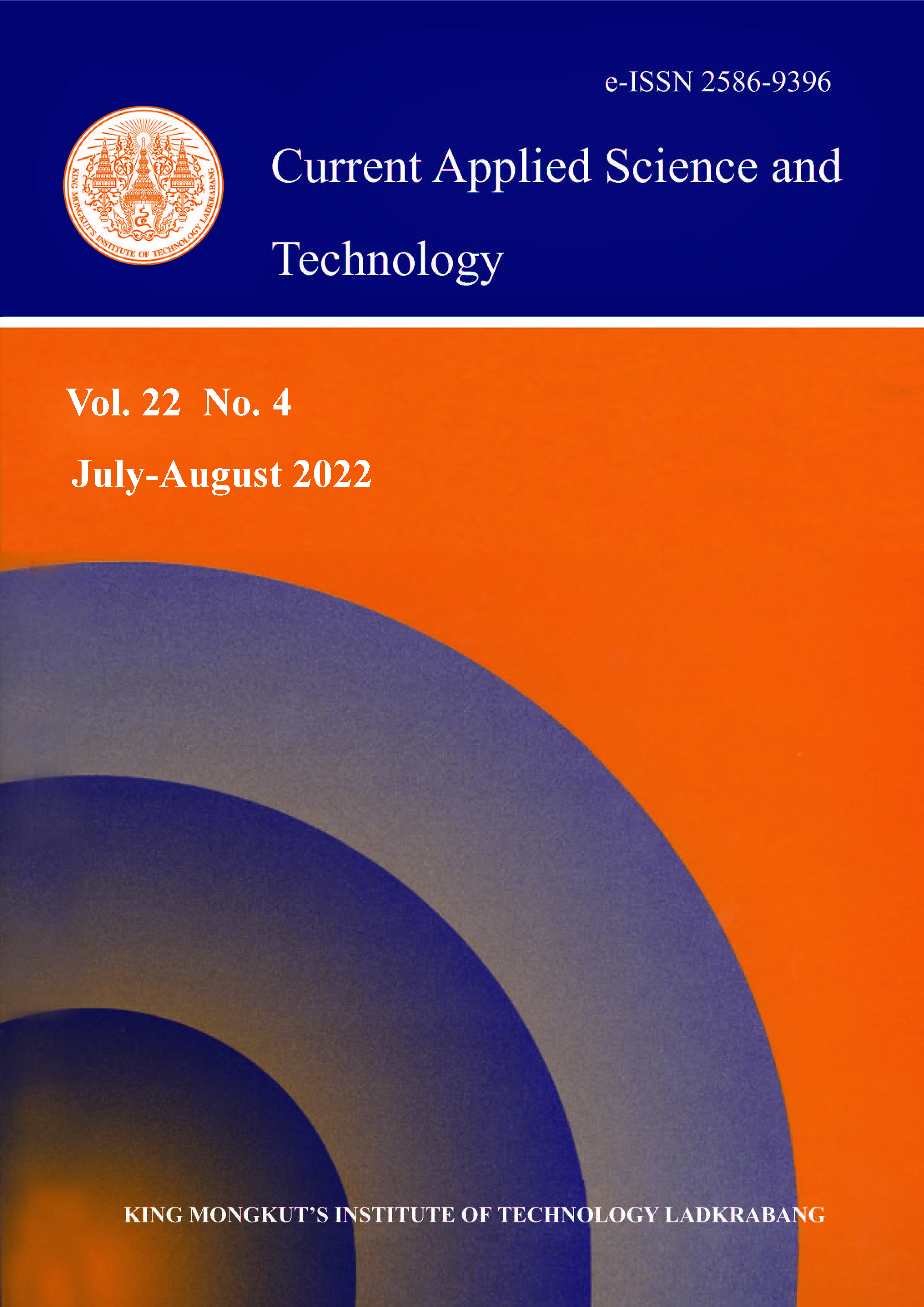Determination of the Firing Temperature and Optimum Ratio of Valorizing Rice Husk Ash, Clear Glass Cullet and Ranong Clay for Developing Ecological Wall Tiles
Main Article Content
Abstract
The purposes of this study were to investigate the effect of firing temperature and utilizing residue materials on the physical properties and microstructure of the ecological wall tiles. Rice husk ash (RHA), clear glass cullet (CGC), and Ranong clay (RNC) were utilized. Eleven formulations were constructed and divided into two groups with different contents of RHA, at 10% and 20%. After molding by uniaxial pressing at 10 MPa, the tested specimens were fired at temperatures of 950 and 1050ºC, with heating rate of 100ºC/h, and soaked for 1 h. The bending strength of specimens fired at 1050ºC were enhanced by up to 205% compared with specimens fired at 950ºC. Formula B1, fired at 1050oC was optimal for further commercial production. It utilized 20 wt% RHA, 50 wt% CGC, and 30 wt% RNC which met the criteria of the Thai Industrial Standard (TIS) 2508-2555 type BIII. Moreover, the microstructure of specimens was characterized by scanning electron microscopy (SEM). It revealed that a glassy phase had developed in the high bending strength specimens under the influence of high firing temperature and CGC content. In addition, RHA residue material promoted a greyish color in ceramic bodies. Finally, it can be concluded that the valorization of RHA, CGC, and RNC in the development of ecological wall tiles with white-greyish texture was feasible.
Keywords: eco-friendly; wall tiles; rice husk ash; clear glass cullet; waste utilization
*Corresponding author: Tel.: (+66) 846763237
E-mail: ubolrat.w@eng.kmutnb.ac.th
Article Details

This work is licensed under a Creative Commons Attribution-NonCommercial-NoDerivatives 4.0 International License.
Copyright Transfer Statement
The copyright of this article is transferred to Current Applied Science and Technology journal with effect if and when the article is accepted for publication. The copyright transfer covers the exclusive right to reproduce and distribute the article, including reprints, translations, photographic reproductions, electronic form (offline, online) or any other reproductions of similar nature.
The author warrants that this contribution is original and that he/she has full power to make this grant. The author signs for and accepts responsibility for releasing this material on behalf of any and all co-authors.
Here is the link for download: Copyright transfer form.pdf
References
Chuasuwan, D., 2018. Rice Industry. [online] Available at: https://www.krungsri.com/bank/getmedia/f229bd87-0e17-42d3-a71200ae07989ada/IO_Rice 2018_EN.aspx.
Piyarat, N., Wangrakdiskul, W. and Maingam, P., 2021. Investigations of the influence of various industrial waste materials containing rice husk ash, waste glass, and sediment soil for eco-friendly production of non-fired tiles. AIMS Materials Science, 8(3), 469-485.
Pollution Control Department, 2016. Thailand State of Pollution Report 2016. [online] Available at: https://www.stkc.go.th/sites/default/files/flip_ebook/catalogs/61_05_PollutionReport2016/pdf/complete.pdf.
Ruenruangrit, P., Laprasert, W. and Sayamipuk, S., 2011. A study on the utilization of cullet for reducing the production cost of sanitaryware. Rajabhat Maha Sarakham University Journal, 5, 211-218 (in Thai).
Bordeepong, S., Bhongsuwan, D., Pungrassami, T. and Bhongsuwan, T., 2012. Mineralogy chemical composition and ceramic properties of clay deposits in southern Thailand. Kasetsart Journal: Natural Science, 46(3), 485-500.
Jitcharnvichai, T., 2015. A use of rice husk ash as a substitute for silica for ceramic products through 1,200ºC sintering. VRU Research and Development Journal, 10(3), 85-94 (in Thai).
Sathitpanawong, L. and Krajangyao, A., 2012. Development refractory brick 1,300 degrees celsius from local clay. Srinakharinwirot University (Journal of Science and Technology), 4(8), 112-121(In Thai).
Furlani, E., Tonello, G., Maschio, S., Aneggi, E., Minichelli, D., Bruckner, S. and Lucchini, E., 2011. Sintering and characterisation of ceramics containing paper sludge, glass cullet and different types of clayey materials. Ceramics International, 37, 1293-1299.
Jitwaree, S., 2016. The effect of cullet and lithium carbonate on reducing sintering temperature of ceramic floor tiles. Industrial Technology Lampang Rajabhat University Journal, 9, 146-160 (in Thai).
Maschio, S., Furlani, E. and Tonello, G., 2009. Fast firing of tiles containing paper mill sludge, glass cullet and clay. Waste Management, 29, 2880-2885.
Sahar, M.R., Hamzah, K., Rohani, M.S. and Razi, M.M., 2011. The microstructural study of cullet-clay ceramics. Physics Procedia, 22, 125-129.
Thai Industrial Standard 2508-2555, 2012. Ceramic Tile. [online] Available at: https://service. tisi.go.th/fulltext/TIS-2508-2555m.pdf.
Piyarat, N., Wangrakdiskul, W. and Maingam, P., 2021. Influence of boric acid additive on physical properties of utilizing wastes for producing eco-friendly fired clay tiles. Key Enginering Material, 889, 83-188.
Esposito, L., Rambaldi, E. and Tucci, A., 2008. Recycle of waste glass into “glass-ceramic stoneware. Journal of the American Ceramic Society, 91, 2156-2162.
Demir, I., 2009. Reuse of waste glass in building brick production. Waste Management and Research, 27, 572-577.
Guo, Y., Zhang, Y., Huang, H., Meng, K., Hu, K., Hu, P., Wang, X., Zhang, Z. and Meng, X., 2014. Novel glass ceramic foams materials based on red mud. Ceramics International, 40(5), 6677-6683.
Azarov, G.M., Maiorova, E.V, Oborina M.A. and Belyakov A.V., 1995. Wollastonite raw materials and their applications (a review). Glass and Ceramics, 52, 237-240.
Maingam, P., Wangrakdiskul, U. and Piyarat, N., 2021. Potential of alternative waste materials: rice husk ash and waste glass cullet with boric acid addition for low-fired unglazed tiles. AIMS Materials Science, 8 (2) 283-300.
De Silva, G.H.M.J.S. and Surangi M.L.C., 2017. Effect of waste rice husk ash on structural, thermal and run-off properties of clay roof tiles. Construction and Building Materials, 154, 251-257.
Wangrakdiskul, U., Maingam, P. and Piyarat, N., 2020. Eco-friendly fired clay tiles with greenish and greyish colored incorporating alternative recycled waste materials. Key Engineering Materials, 856, 376-383.






